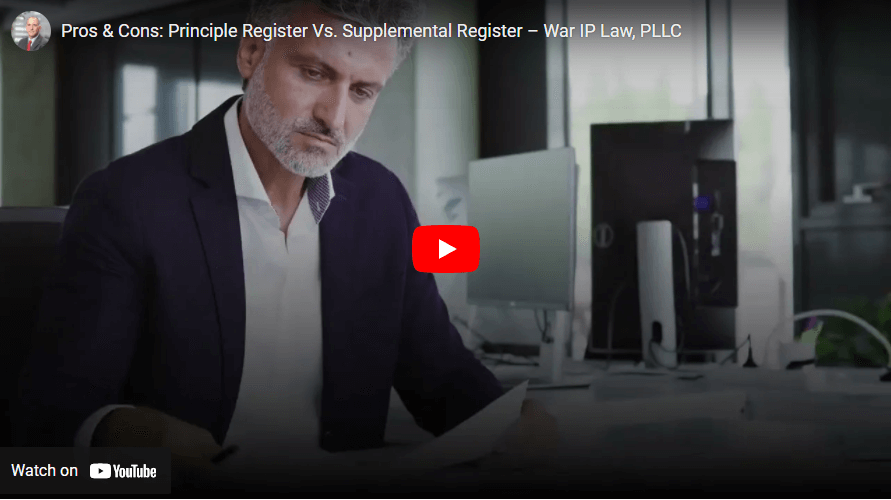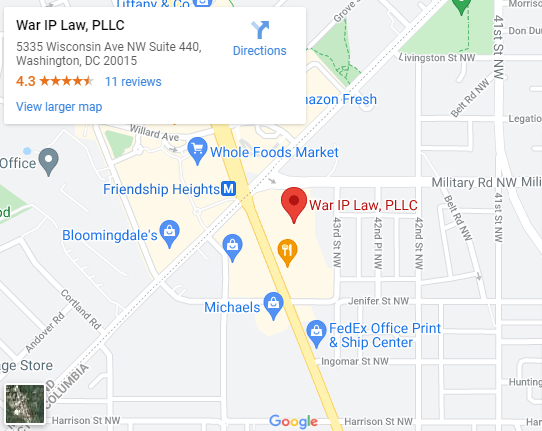Trademark registration is integral to protecting one’s intellectual property (IP). As such, countless companies, creatives, and inventors have sought trademark protection for their brand names and logos. In many cases, trademarks work in tandem with other protections, such as copyright or patents. For some businesses, however, trademark registration is the first step to comprehensive IP protection. Therefore, understanding the differences between the Principal Register and the Supplemental Register is critical. Whether you are a company or an individual in the midst of starting a business, obtaining trademark registration is a key aspect to the success and longevity of your business venture. At War IP Law, PLLC, we advocate for our clients and take a holistic approach to IP protection. In this resource, we aim to provide you with baseline knowledge, but for more detailed information regarding the Principal Register vs. the Supplemental Register, consider contacting us at (202) 800-3754 today.
The United States Patent and Trademark Office
The United States Patent and Trademark Office (USPTO) recognizes two different types of trademark registrations: the Principal Register and the Supplemental Register. While the Principal Register is most frequently used, there are special circumstances that call for the use of the Supplemental Register. In some cases an experienced intellectual property attorney may recommend the use of a Supplemental Register, as it can be difficult to navigate how and when to utilize this approach.
What Is the Principal Register?
The Principal Register is far more common for intellectual property submissions. Since trademarks protect logos and brand names used for a good or service, they must be unique and distinct from any pre-existing trademark. Principal Registers are used for only the most unique and distinct trademarks.
The USPTO uses “distinctiveness” as a litmus test for whether a mark can be registered on the Principal Register. Distinctiveness is present when the products and goods designated by one mark can be reasonably distinguished from that of another mark. It can be helpful to think of this as the originality of the mark. The mark cannot be easily confused with another nor can it blatantly describe the goods or services that it offers. As long as an applicant can prove sufficient distinctiveness, they can likely be registered on the Principal Register.
Benefits Of The Principal Register
The Principal Register is quite comprehensive and offers a wide array of legal protections. This is because the Principal Register calls for a higher level of distinctiveness than the supplemental register. Under Trademark Manual of Examining Procedure (TMEP) 801.02(a), the Principal Register provides the following advantages:
- Establishes the presumption of ownership and the exclusive right to use the mark in commerce
- Notices the public of the registrant’s ownership of the mark
- Designates the date of use as the filing date of the trademark application
- States that the registrant has the ability to bring court action against infringers
- Stipulates that the registrant’s exclusive right to the mark can become “incontestable” under certain statutory circumstances, for example after five years on the Principal Register
- Provides a basis to obtain registration in other countries
The law offers greater protection for marks on the Principal Register primarily because the marks have exceeded the highest threshold of distinctiveness, reserved for the most unique trademarks. This factor underscores the discussion surrounding the Principal Register vs the Supplement Register.
What Is The Supplemental Register?
The Supplemental Register is available to marks that have not met the high threshold of distinctiveness. This is quite common, as marks are commonly denied from the Principal Register due to their “mere descriptiveness” or “likelihood of confusion.”
The USPTO favors marks that do not directly describe the products or goods that the mark is connected to. There must be some level of creativity or uniqueness present for a mark to be easily accepted onto the Principal Register. Many marks, however, fall into a grey area of suggestiveness or descriptiveness. While these types of marks are commonly rejected for the Principal Register, they may find protection on the Supplemental Register.
Understanding Distinctiveness
Marks that are not eligible for registration on the Principal Register, but are still capable of distinguishing the goods or services, may apply for registration on the Supplemental Register. The caveat is that the applicant must prove that their mark can acquire distinctiveness. The USPTO calls this “secondary meaning.” This is typically done by proving the commercial use and potential of the applicant’s mark.
There are several strategies available to prove that a mark can acquire distinctiveness. For instance, in Corning Glass Works v. Anchor Hocking Glass Corp., 300 F. Supp. 1299, 163 U.S.P.Q. (BNA) 268 (D. Del. 1969), Corning Glass Works provided extensive evidence of the prominent use of their design in advertising, on the aprons of sales promotion representatives, and through surveys and statements by purchasers, indicating they saw the design as original.
Benefits Of The Supplemental Register
Marks registered on the Supplemental Register may bear the traditional trademark symbol and block other applications for marks that are considered too similar. Just like the Principal Register does, the Supplemental Register allows for lawsuits regarding trademark infringement, which is an important legal protection. Moreover, registrants on the Supplemental Register may reapply for the Principal Register after five years’ time.
Applying For The Principal Register vs. Supplemental Register With An IP Attorney
An applicant cannot submit a trademark application for both the Principal Register and the Supplemental Register at the same time. Only one approach is available at a time. Facing Principal Register rejection can severely delay the intellectual protection of a trademark, which can be highly detrimental to the applicant. Because of this, it is advised to carefully weigh your options and select the best course of action for your specific mark.
The USPTO is quite selective with trademark registration, but the experienced team of IP attorneys at War IP Law, PLLC understand how to navigate the hoops of registration on the Principal Register or on the Supplemental Register. Seeking legal assistance can help alleviate the burden of uncertainty and the potential of trademark rejection. Contact our experienced legal team at 202-800-3754 and speak with a licensed IP attorney today.







